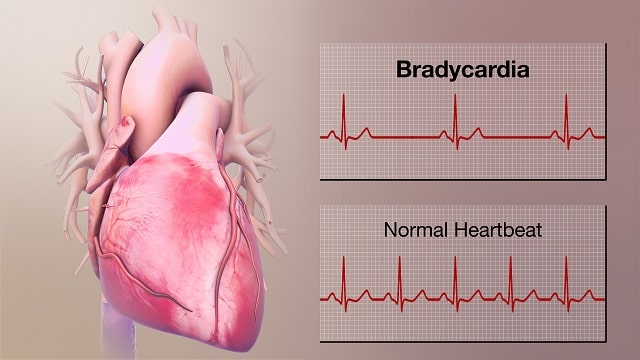Bradycardia is a condition where the heart beats slower than normal. The normal resting heart rate for adults is 60-100 beats per minute. However, the heart rate of people with bradycardia is below 60 beats per minute.
In some people, a slow heart rate does not cause any medical problems. However, in others, bradycardia can be a sign of a problem with the heart’s electrical system.
This disorder can also prevent the heart from pumping enough oxygen-rich blood throughout the body. This can result in dizziness, fatigue, shortness of breath, and even death.
However, a slow heart rate can occur in certain conditions. For example, when resting or sleeping. Even trained athletes also have slower heart rates than other normal people.
Symptoms of Bradycardia
If bradycardia causes insufficient oxygen supply to the body and brain, a person usually experiences the following symptoms:
- Memory disorders.
- Dizziness or mild headache.
- Confusion or memory problems.
- Fainting (syncope) or near fainting.
- Shortness of breath or labored breathing.
- Difficulty concentrating.
- Chest pain.
- Easily tired during physical activity.
Then, if you feel difficulty breathing or chest pain for a few minutes, see a doctor immediately.
If you check your heart rate and it is regularly below 60 beats per minute, you should be concerned. If it is not causing symptoms, you do not need to see a doctor. You may just need to exercise more to get better.
Causes of Bradycardia
The cause of this problem is something that interferes with the electrical impulses that control the heartbeat. Many things can cause this disorder, some of which are:
- There is an electrolyte imbalance in the body.
- Damage to heart tissue due to age, heart attack, or certain diseases.
- High blood pressure or hypertension.
- Heart defects at birth.
- Infection of the heart tissue.
- Inflammation of the heart tissue (myocarditis).
- Complications during heart surgery.
- An underactive thyroid gland (hypothyroidism).
- Recurrent breathing disorders during sleep.
- Repeated pauses in breathing during sleep ( obstructive sleep apnea ).
- Imbalance of chemicals in the blood, such as potassium or calcium.
- Inflammatory diseases, such as rheumatic fever or lupus.
- Accumulation of iron in body organs.
- Drugs.
- Disorders of the sinus nodes, the electrical source of the heart.
- Heart block. A condition caused by disruption of the electrical current that controls the heartbeat.
Risk Factors for Bradycardia
Bradycardia is often associated with tissue damage to the heart from some type of disorder in the organ. It is suspected that anything that increases the risk of heart problems can also increase the risk of this slow heartbeat. Some risk factors include:
- Older age.
- High blood pressure.
- Smoking habit.
- The habit of consuming alcohol.
- Use of illegal drugs.
- Experience stress and anxiety.
It is known that the way to reduce these risk factors is by making lifestyle changes to be healthier or undergoing medical treatment that can reduce the risk of heart disease.
Diagnosis of Bradycardia
The doctor will start with a medical interview as the first step. Questions and answers related to the symptoms experienced, medical history experienced by yourself and family members, to the history of drug consumption. After that, the doctor will use a stethoscope to check the heartbeat and follow with blood pressure measurement.
Doctors can also perform supporting examinations to ensure the presence or absence of bradycardia. The main examination for this disorder is an electrocardiography (ECG) test. This method is useful for examining the electrical flow in the heart. Another alternative is the Holter monitoring test. This tool can help doctors to examine the electrical flow of the heart for up to a full day during activities.
Treatment of Bradycardia
Treatment for bradycardia is usually adjusted to the causative factors and severity and type of disorder that occurs in the heart. If bradycardia does not cause any symptoms, medical action may not be necessary. Also, make sure to address the problem that is causing this slower heartbeat.
In most cases, a pacemaker implanted under the collarbone can be used as a treatment. This method works to produce the electrical impulses needed to maintain the rhythm of the heartbeat. That way, a normal heartbeat can be maintained at all times.
Complications of Bradycardia
Do not underestimate this medical condition. Because bradycardia that is not treated effectively can cause other problems. Here are some complications of this disorder:
- The inability of the heart to pump enough blood (heart failure).
- Chest pain (angina pectoris).
- Hypertension.
- Hypotension.
- Syncope or fainting.
- Sudden cardiac arrest or sudden death.
Prevention of Bradycardia
Bradycardia usually cannot be prevented, but healthcare providers recommend ways to reduce the risk of developing heart disease. Some steps you can take are:
- Exercise regularly.
- Follow a healthy diet.
- Control ideal body weight.
- Maintains blood pressure and cholesterol levels.
- Quit smoking.
- Do not consume alcoholic beverages excessively.
- Do not take illegal drugs.
- Avoid stress.
- Have regular heart check-ups.
- Take medication according to the doctor’s instructions.
- Seek immediate medical attention if symptoms worsen.
When to See a Doctor?
If you experience a sudden irregular heart rhythm or experience symptoms related to bradycardia, talk to your doctor immediately for further examination and to take the necessary action.

